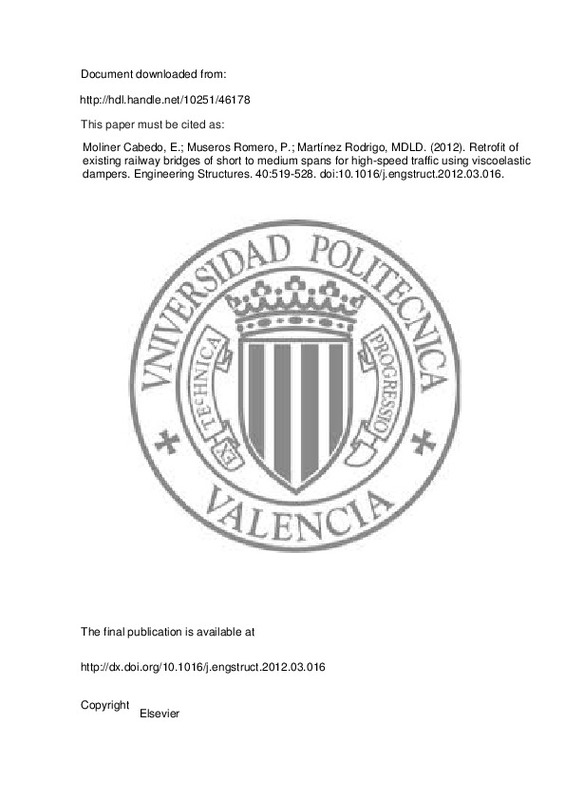JavaScript is disabled for your browser. Some features of this site may not work without it.
Buscar en RiuNet
Listar
Mi cuenta
Estadísticas
Ayuda RiuNet
Admin. UPV
Forward Algorithm for the construction control of cable-stayed bridges built on temporary supports
Mostrar el registro sencillo del ítem
Ficheros en el ítem
| dc.contributor.author | Lozano-Galant, Jose A.
|
es_ES |
| dc.contributor.author | Paya-Zaforteza, I.
|
es_ES |
| dc.contributor.author | Xu, Dong
|
es_ES |
| dc.contributor.author | Turmo Coderque, José
|
es_ES |
| dc.date.accessioned | 2015-02-03T11:31:43Z | |
| dc.date.available | 2015-02-03T11:31:43Z | |
| dc.date.issued | 2012-07 | |
| dc.identifier.issn | 0141-0296 | |
| dc.identifier.uri | http://hdl.handle.net/10251/46674 | |
| dc.description.abstract | Traditionally the construction process of cable-stayed bridges is modeled according to the backward approach, as its calculation is much easier using an elastic analysis. In this approach the bridge is disassembled according to the opposite sequence of events which occur during its erection. The main trade off of the backward approach is that time-dependent phenomena, such as creep, shrinkage or cable relaxation, cannot be directly computed as the analysis is performed according to the reversed time direction.In this paper the Forward Algorithm (FA) that is based on the forward approach is formally presented. This procedure has been applied to the temporary supports erection method as no specific investigation of this erection technique has been found by the authors. The FA has the following advantages: (1) Modifications in design and/or tensioning strategy can be easily computed. (2) The effect of time-dependent phenomena can be efficiently included into the calculation of the construction process of the bridge. (3) Differences between the temperatures in the structural elements assumed when doing the structural analysis of the bridge and the real ones when built can be calculated without the need of separate models. (4) The stresses in the mono-strands when the strand by strand prestressing technique is used are obtained directly. (5) Stay and strand elongation, which are very useful to control the prestressing operations, can be also easily computed. All these features make the FA an efficient procedure to control the construction process on site, increasing safety during construction and decreasing construction time. © 2012 Elsevier Ltd. | es_ES |
| dc.description.sponsorship | Part of this work was done through a collaborative agreement between University of Castilla-La Mancha (Spain) and Tongji University (China). This included an exchange of faculty and scholars. The finantial support from Kwang-Hua Foundation from College of Civil Engineering of Tongji University and from the International Relation Office of University of Castilla-La Mancha is greatly appreciated. | en_EN |
| dc.language | Inglés | es_ES |
| dc.publisher | Elsevier | es_ES |
| dc.relation.ispartof | Engineering Structures | es_ES |
| dc.rights | Reserva de todos los derechos | es_ES |
| dc.subject | Cable-stayed bridge | es_ES |
| dc.subject | Construction control | es_ES |
| dc.subject | Forward modeling | es_ES |
| dc.subject | Iterative process | es_ES |
| dc.subject | Temporary supports erection method | es_ES |
| dc.subject | Construction process | es_ES |
| dc.subject | Construction time | es_ES |
| dc.subject | During construction | es_ES |
| dc.subject | Elastic analysis | es_ES |
| dc.subject | Erection techniques | es_ES |
| dc.subject | Forward algorithms | es_ES |
| dc.subject | Sequence of events | es_ES |
| dc.subject | Structural elements | es_ES |
| dc.subject | Temporary support | es_ES |
| dc.subject | Time dependent phenomena | es_ES |
| dc.subject | Trade off | es_ES |
| dc.subject | Algorithms | es_ES |
| dc.subject | Box girder bridges | es_ES |
| dc.subject | Cable stayed bridges | es_ES |
| dc.subject | Prestressing | es_ES |
| dc.subject | Cables | es_ES |
| dc.subject | Algorithm | es_ES |
| dc.subject | Bridge | es_ES |
| dc.subject | Construction method | es_ES |
| dc.subject | Structural analysis | es_ES |
| dc.subject.classification | INGENIERIA CARTOGRAFICA, GEODESIA Y FOTOGRAMETRIA | es_ES |
| dc.subject.classification | PROYECTOS DE INGENIERIA | es_ES |
| dc.subject.classification | INGENIERIA DE LA CONSTRUCCION | es_ES |
| dc.title | Forward Algorithm for the construction control of cable-stayed bridges built on temporary supports | es_ES |
| dc.type | Artículo | es_ES |
| dc.identifier.doi | 10.1016/j.engstruct.2012.02.022 | |
| dc.relation.projectID | info:eu-repo/grantAgreement/MICINN//BIA2009-13056/ES/Estudio Experimental Del Coeficiente De Rozamiento Entre Dovelas Prefabricadas De Hormigon Para Puentes Con Junta Seca Conjugada/ | es_ES |
| dc.relation.projectID | info:eu-repo/grantAgreement/Junta de Comunidades de Castilla-La Mancha//PII2I09-0129-4085/ES/Optimización Del Proceso De Tesado De Puentes Atirantados Construidos Con Tableros Apeados/ | es_ES |
| dc.rights.accessRights | Cerrado | es_ES |
| dc.contributor.affiliation | Universitat Politècnica de València. Departamento de Ingeniería de la Construcción y de Proyectos de Ingeniería Civil - Departament d'Enginyeria de la Construcció i de Projectes d'Enginyeria Civil | es_ES |
| dc.contributor.affiliation | Universitat Politècnica de València. Instituto de Ciencia y Tecnología del Hormigón - Institut de Ciència i Tecnologia del Formigó | es_ES |
| dc.description.bibliographicCitation | Lozano-Galant, JA.; Paya-Zaforteza, I.; Xu, D.; Turmo Coderque, J. (2012). Forward Algorithm for the construction control of cable-stayed bridges built on temporary supports. Engineering Structures. 40:119-130. doi:10.1016/j.engstruct.2012.02.022 | es_ES |
| dc.description.accrualMethod | S | es_ES |
| dc.relation.publisherversion | http://dx.doi.org/10.1016/j.engstruct.2012.02.022 | es_ES |
| dc.description.upvformatpinicio | 119 | es_ES |
| dc.description.upvformatpfin | 130 | es_ES |
| dc.type.version | info:eu-repo/semantics/publishedVersion | es_ES |
| dc.description.volume | 40 | es_ES |
| dc.relation.senia | 223574 | |
| dc.contributor.funder | Junta de Comunidades de Castilla-La Mancha | |
| dc.contributor.funder | Ministerio de Ciencia e Innovación | es_ES |






![[Cerrado]](/themes/UPV/images/candado.png)


